Analysis of Environmental Policy Issues in Australia - Report
VerifiedAdded on 2021/02/19
|10
|2943
|100
Report
AI Summary
This report provides an in-depth analysis of environmental policy issues in Australia. It begins by defining environmental planning and its importance in balancing natural and human systems, then identifies key challenges faced by policymakers, such as climate change, urban climate governance, and environmental tax reforms. The report examines Australia's response to climate change, including the Emission Trading Scheme (ETS) and the Emission Reduction Fund (ERF), evaluating their effectiveness in controlling carbon emissions. It highlights the shortcomings of the ERF, particularly its lack of strict emission caps and penalties, and suggests improvements to ensure Australia meets its emission reduction targets. The report also addresses the impacts of pollution from factories and the existing policies designed to protect natural resources and environment. The evaluation of existing policies, the report suggests that the current strategies can be effective if the government improves its policies, especially the ERF program.
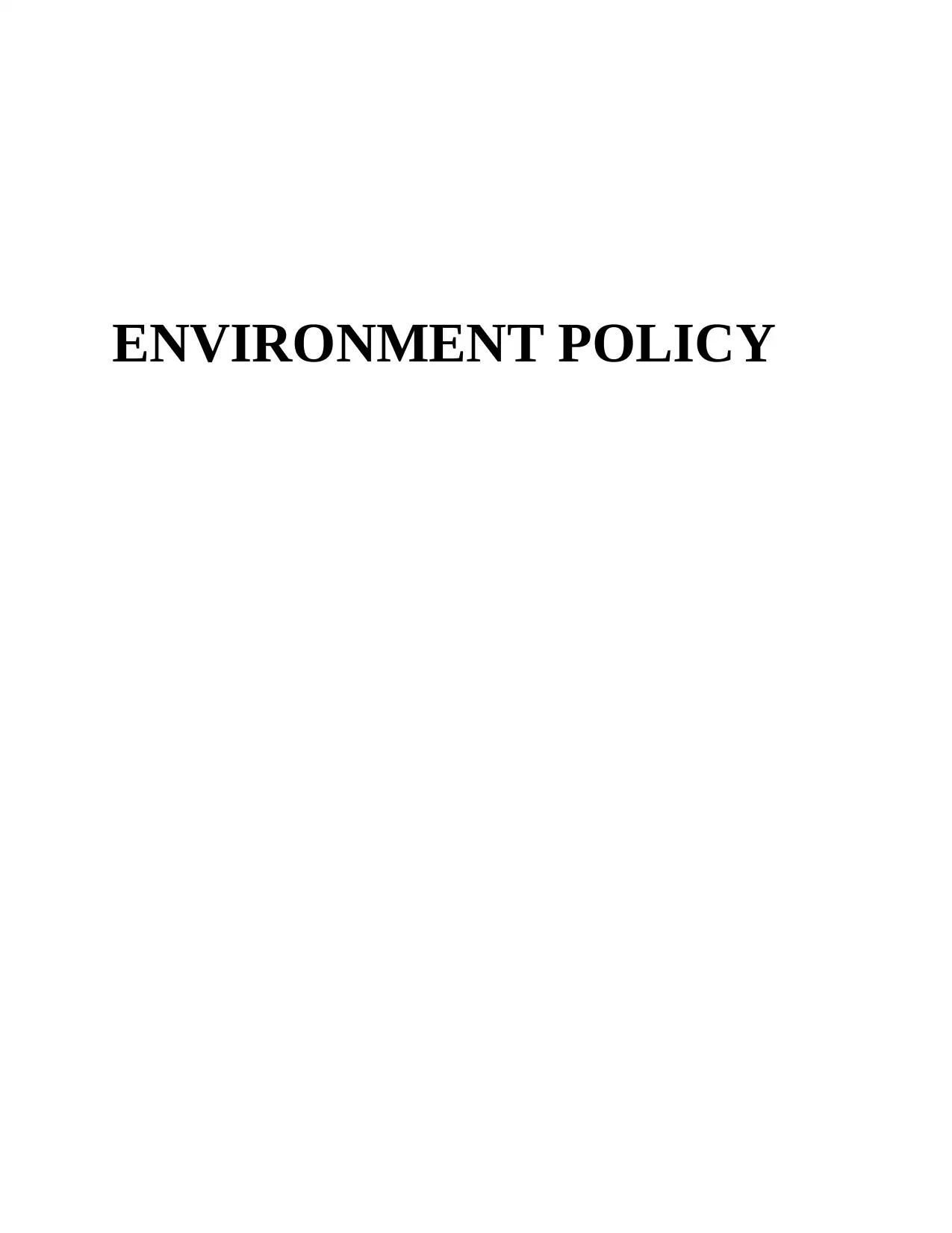
ENVIRONMENT POLICY
Paraphrase This Document
Need a fresh take? Get an instant paraphrase of this document with our AI Paraphraser
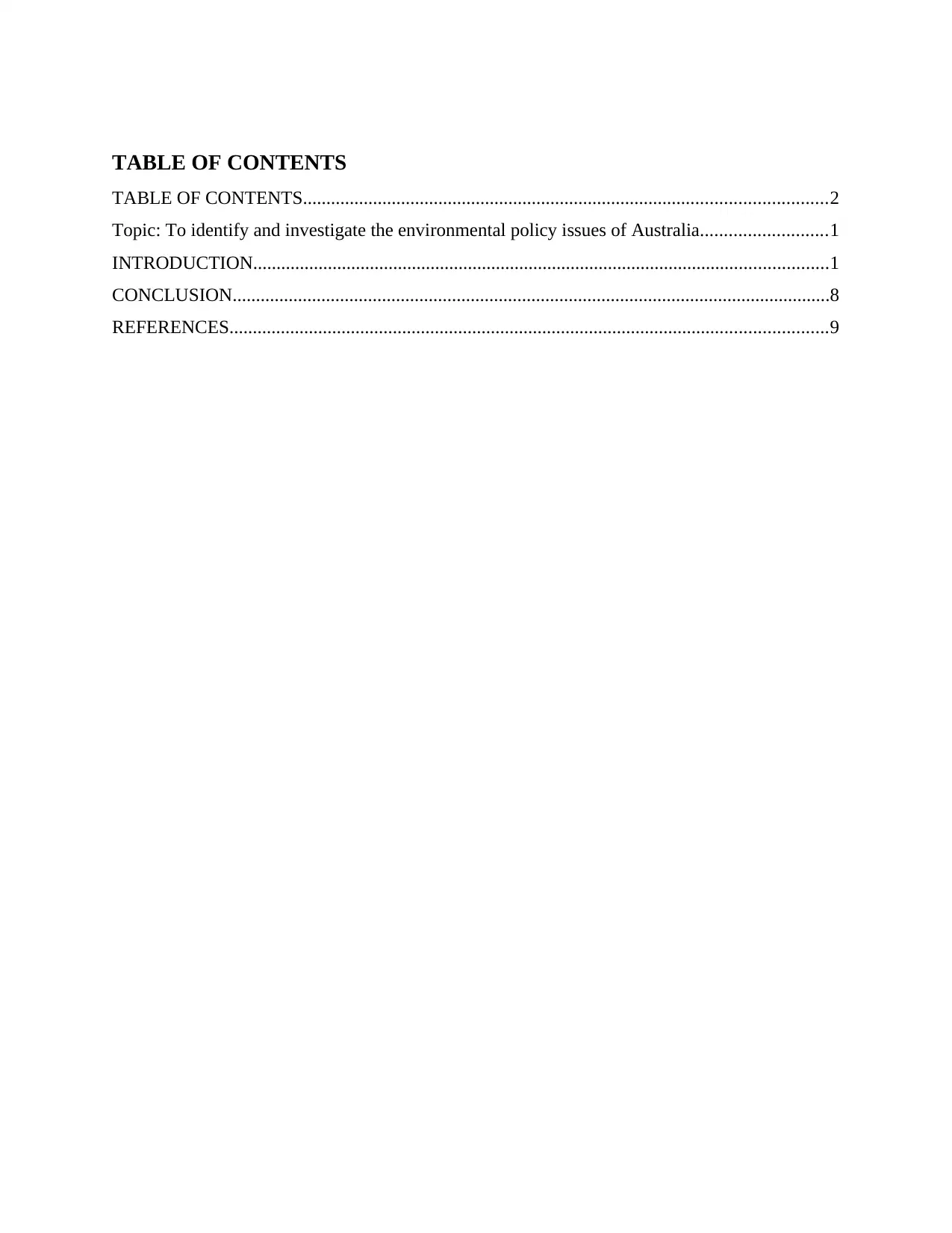
TABLE OF CONTENTS
TABLE OF CONTENTS................................................................................................................2
Topic: To identify and investigate the environmental policy issues of Australia...........................1
INTRODUCTION...........................................................................................................................1
CONCLUSION................................................................................................................................8
REFERENCES................................................................................................................................9
TABLE OF CONTENTS................................................................................................................2
Topic: To identify and investigate the environmental policy issues of Australia...........................1
INTRODUCTION...........................................................................................................................1
CONCLUSION................................................................................................................................8
REFERENCES................................................................................................................................9
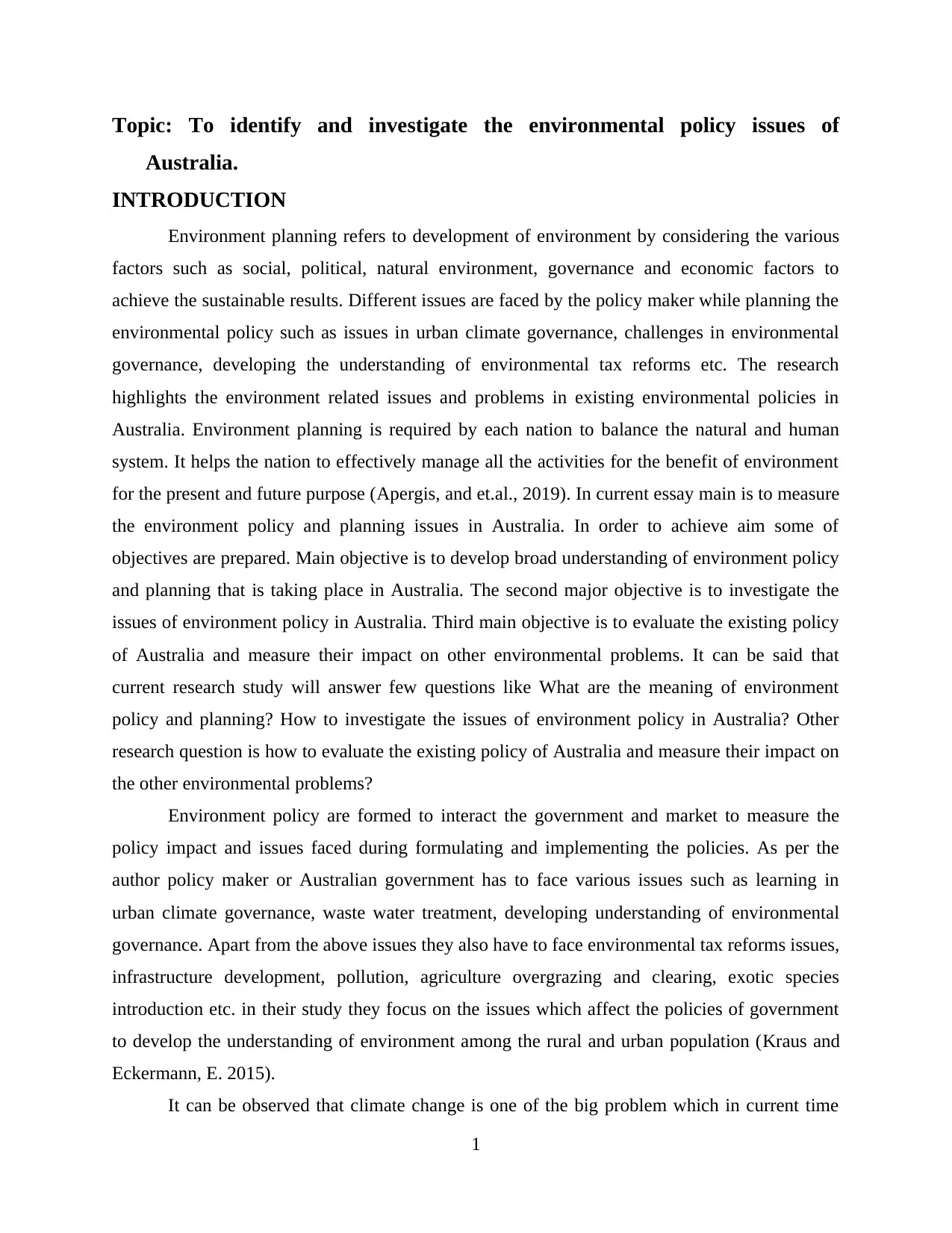
Topic: To identify and investigate the environmental policy issues of
Australia.
INTRODUCTION
Environment planning refers to development of environment by considering the various
factors such as social, political, natural environment, governance and economic factors to
achieve the sustainable results. Different issues are faced by the policy maker while planning the
environmental policy such as issues in urban climate governance, challenges in environmental
governance, developing the understanding of environmental tax reforms etc. The research
highlights the environment related issues and problems in existing environmental policies in
Australia. Environment planning is required by each nation to balance the natural and human
system. It helps the nation to effectively manage all the activities for the benefit of environment
for the present and future purpose (Apergis, and et.al., 2019). In current essay main is to measure
the environment policy and planning issues in Australia. In order to achieve aim some of
objectives are prepared. Main objective is to develop broad understanding of environment policy
and planning that is taking place in Australia. The second major objective is to investigate the
issues of environment policy in Australia. Third main objective is to evaluate the existing policy
of Australia and measure their impact on other environmental problems. It can be said that
current research study will answer few questions like What are the meaning of environment
policy and planning? How to investigate the issues of environment policy in Australia? Other
research question is how to evaluate the existing policy of Australia and measure their impact on
the other environmental problems?
Environment policy are formed to interact the government and market to measure the
policy impact and issues faced during formulating and implementing the policies. As per the
author policy maker or Australian government has to face various issues such as learning in
urban climate governance, waste water treatment, developing understanding of environmental
governance. Apart from the above issues they also have to face environmental tax reforms issues,
infrastructure development, pollution, agriculture overgrazing and clearing, exotic species
introduction etc. in their study they focus on the issues which affect the policies of government
to develop the understanding of environment among the rural and urban population (Kraus and
Eckermann, E. 2015).
It can be observed that climate change is one of the big problem which in current time
1
Australia.
INTRODUCTION
Environment planning refers to development of environment by considering the various
factors such as social, political, natural environment, governance and economic factors to
achieve the sustainable results. Different issues are faced by the policy maker while planning the
environmental policy such as issues in urban climate governance, challenges in environmental
governance, developing the understanding of environmental tax reforms etc. The research
highlights the environment related issues and problems in existing environmental policies in
Australia. Environment planning is required by each nation to balance the natural and human
system. It helps the nation to effectively manage all the activities for the benefit of environment
for the present and future purpose (Apergis, and et.al., 2019). In current essay main is to measure
the environment policy and planning issues in Australia. In order to achieve aim some of
objectives are prepared. Main objective is to develop broad understanding of environment policy
and planning that is taking place in Australia. The second major objective is to investigate the
issues of environment policy in Australia. Third main objective is to evaluate the existing policy
of Australia and measure their impact on other environmental problems. It can be said that
current research study will answer few questions like What are the meaning of environment
policy and planning? How to investigate the issues of environment policy in Australia? Other
research question is how to evaluate the existing policy of Australia and measure their impact on
the other environmental problems?
Environment policy are formed to interact the government and market to measure the
policy impact and issues faced during formulating and implementing the policies. As per the
author policy maker or Australian government has to face various issues such as learning in
urban climate governance, waste water treatment, developing understanding of environmental
governance. Apart from the above issues they also have to face environmental tax reforms issues,
infrastructure development, pollution, agriculture overgrazing and clearing, exotic species
introduction etc. in their study they focus on the issues which affect the policies of government
to develop the understanding of environment among the rural and urban population (Kraus and
Eckermann, E. 2015).
It can be observed that climate change is one of the big problem which in current time
1
⊘ This is a preview!⊘
Do you want full access?
Subscribe today to unlock all pages.

Trusted by 1+ million students worldwide
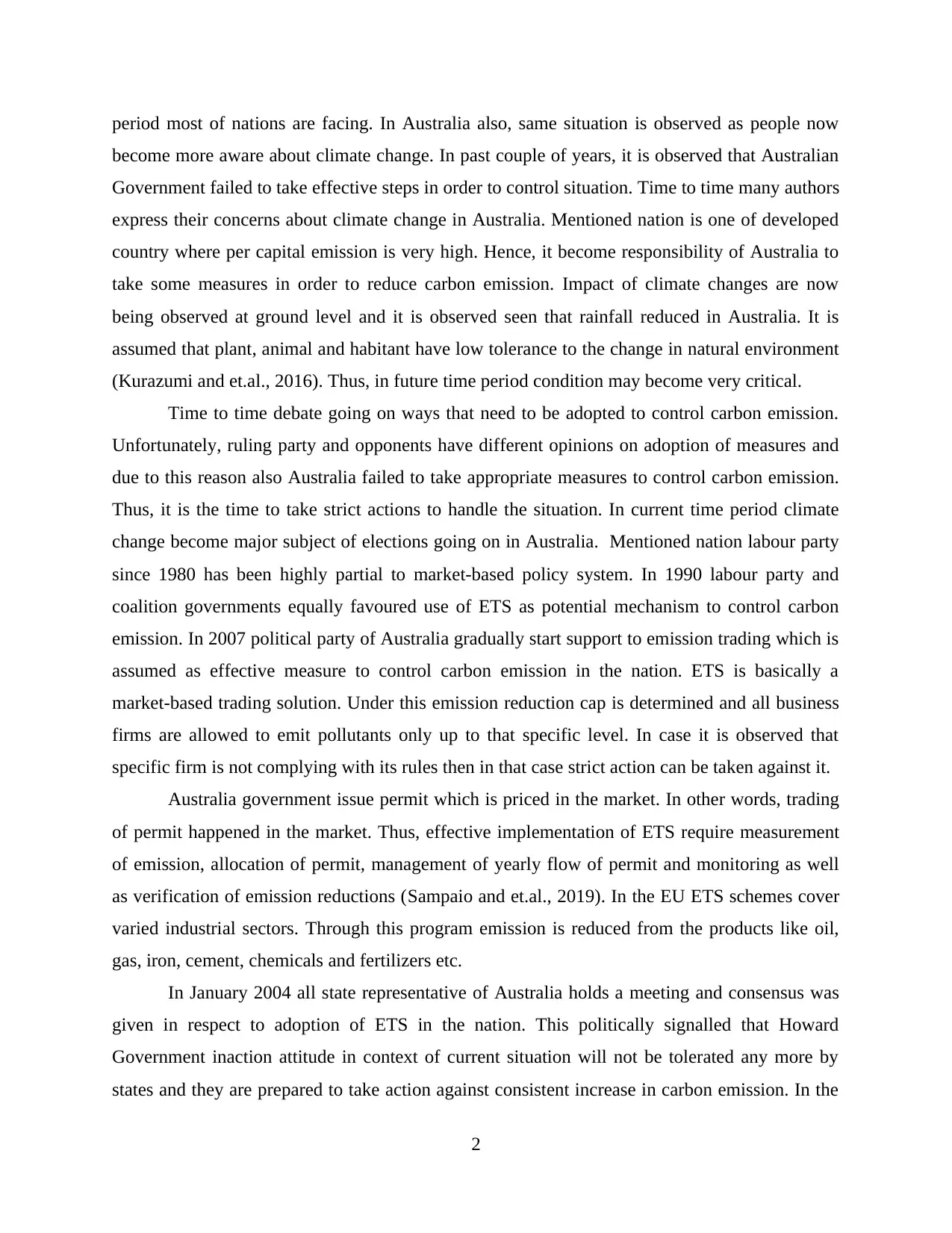
period most of nations are facing. In Australia also, same situation is observed as people now
become more aware about climate change. In past couple of years, it is observed that Australian
Government failed to take effective steps in order to control situation. Time to time many authors
express their concerns about climate change in Australia. Mentioned nation is one of developed
country where per capital emission is very high. Hence, it become responsibility of Australia to
take some measures in order to reduce carbon emission. Impact of climate changes are now
being observed at ground level and it is observed seen that rainfall reduced in Australia. It is
assumed that plant, animal and habitant have low tolerance to the change in natural environment
(Kurazumi and et.al., 2016). Thus, in future time period condition may become very critical.
Time to time debate going on ways that need to be adopted to control carbon emission.
Unfortunately, ruling party and opponents have different opinions on adoption of measures and
due to this reason also Australia failed to take appropriate measures to control carbon emission.
Thus, it is the time to take strict actions to handle the situation. In current time period climate
change become major subject of elections going on in Australia. Mentioned nation labour party
since 1980 has been highly partial to market-based policy system. In 1990 labour party and
coalition governments equally favoured use of ETS as potential mechanism to control carbon
emission. In 2007 political party of Australia gradually start support to emission trading which is
assumed as effective measure to control carbon emission in the nation. ETS is basically a
market-based trading solution. Under this emission reduction cap is determined and all business
firms are allowed to emit pollutants only up to that specific level. In case it is observed that
specific firm is not complying with its rules then in that case strict action can be taken against it.
Australia government issue permit which is priced in the market. In other words, trading
of permit happened in the market. Thus, effective implementation of ETS require measurement
of emission, allocation of permit, management of yearly flow of permit and monitoring as well
as verification of emission reductions (Sampaio and et.al., 2019). In the EU ETS schemes cover
varied industrial sectors. Through this program emission is reduced from the products like oil,
gas, iron, cement, chemicals and fertilizers etc.
In January 2004 all state representative of Australia holds a meeting and consensus was
given in respect to adoption of ETS in the nation. This politically signalled that Howard
Government inaction attitude in context of current situation will not be tolerated any more by
states and they are prepared to take action against consistent increase in carbon emission. In the
2
become more aware about climate change. In past couple of years, it is observed that Australian
Government failed to take effective steps in order to control situation. Time to time many authors
express their concerns about climate change in Australia. Mentioned nation is one of developed
country where per capital emission is very high. Hence, it become responsibility of Australia to
take some measures in order to reduce carbon emission. Impact of climate changes are now
being observed at ground level and it is observed seen that rainfall reduced in Australia. It is
assumed that plant, animal and habitant have low tolerance to the change in natural environment
(Kurazumi and et.al., 2016). Thus, in future time period condition may become very critical.
Time to time debate going on ways that need to be adopted to control carbon emission.
Unfortunately, ruling party and opponents have different opinions on adoption of measures and
due to this reason also Australia failed to take appropriate measures to control carbon emission.
Thus, it is the time to take strict actions to handle the situation. In current time period climate
change become major subject of elections going on in Australia. Mentioned nation labour party
since 1980 has been highly partial to market-based policy system. In 1990 labour party and
coalition governments equally favoured use of ETS as potential mechanism to control carbon
emission. In 2007 political party of Australia gradually start support to emission trading which is
assumed as effective measure to control carbon emission in the nation. ETS is basically a
market-based trading solution. Under this emission reduction cap is determined and all business
firms are allowed to emit pollutants only up to that specific level. In case it is observed that
specific firm is not complying with its rules then in that case strict action can be taken against it.
Australia government issue permit which is priced in the market. In other words, trading
of permit happened in the market. Thus, effective implementation of ETS require measurement
of emission, allocation of permit, management of yearly flow of permit and monitoring as well
as verification of emission reductions (Sampaio and et.al., 2019). In the EU ETS schemes cover
varied industrial sectors. Through this program emission is reduced from the products like oil,
gas, iron, cement, chemicals and fertilizers etc.
In January 2004 all state representative of Australia holds a meeting and consensus was
given in respect to adoption of ETS in the nation. This politically signalled that Howard
Government inaction attitude in context of current situation will not be tolerated any more by
states and they are prepared to take action against consistent increase in carbon emission. In the
2
Paraphrase This Document
Need a fresh take? Get an instant paraphrase of this document with our AI Paraphraser
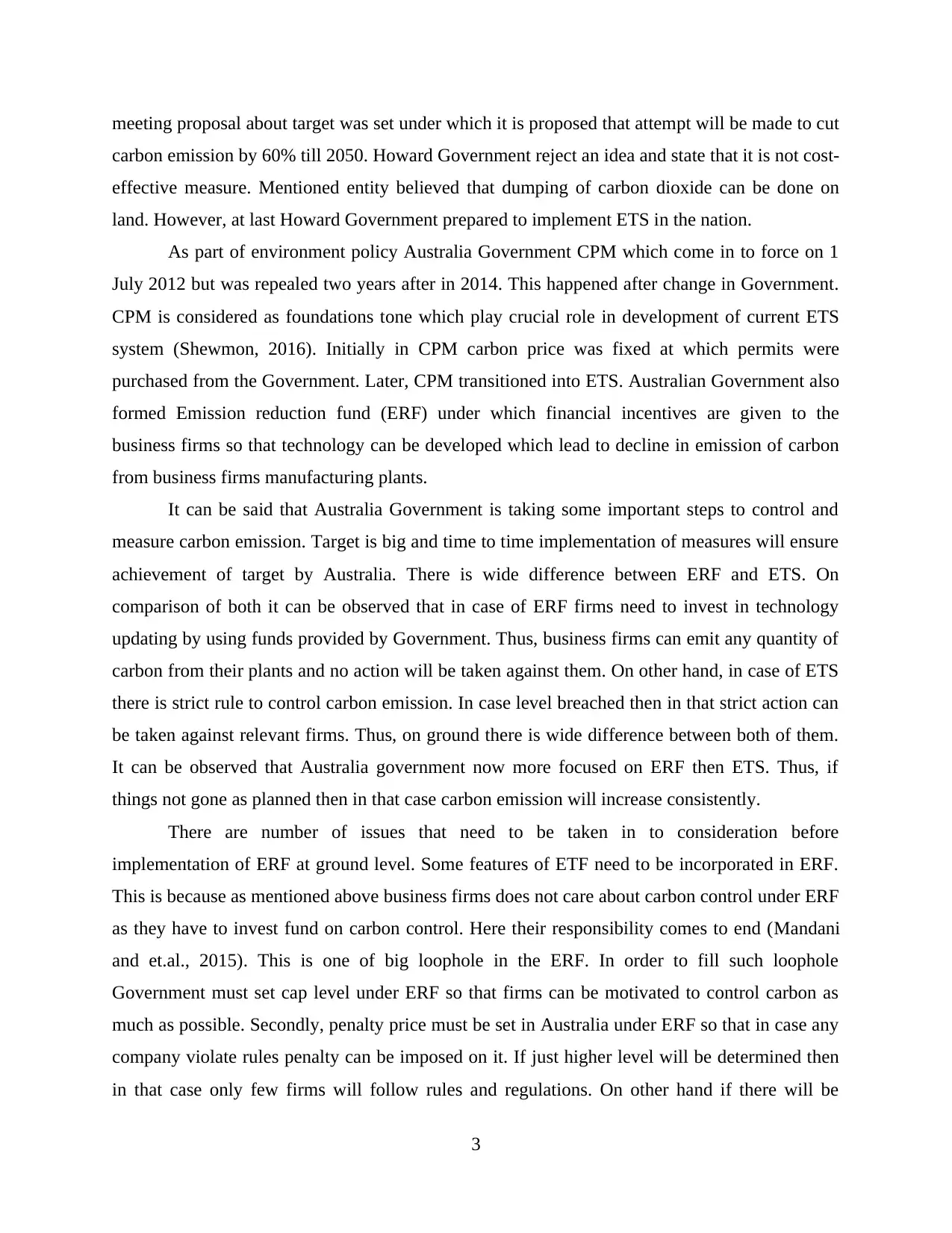
meeting proposal about target was set under which it is proposed that attempt will be made to cut
carbon emission by 60% till 2050. Howard Government reject an idea and state that it is not cost-
effective measure. Mentioned entity believed that dumping of carbon dioxide can be done on
land. However, at last Howard Government prepared to implement ETS in the nation.
As part of environment policy Australia Government CPM which come in to force on 1
July 2012 but was repealed two years after in 2014. This happened after change in Government.
CPM is considered as foundations tone which play crucial role in development of current ETS
system (Shewmon, 2016). Initially in CPM carbon price was fixed at which permits were
purchased from the Government. Later, CPM transitioned into ETS. Australian Government also
formed Emission reduction fund (ERF) under which financial incentives are given to the
business firms so that technology can be developed which lead to decline in emission of carbon
from business firms manufacturing plants.
It can be said that Australia Government is taking some important steps to control and
measure carbon emission. Target is big and time to time implementation of measures will ensure
achievement of target by Australia. There is wide difference between ERF and ETS. On
comparison of both it can be observed that in case of ERF firms need to invest in technology
updating by using funds provided by Government. Thus, business firms can emit any quantity of
carbon from their plants and no action will be taken against them. On other hand, in case of ETS
there is strict rule to control carbon emission. In case level breached then in that strict action can
be taken against relevant firms. Thus, on ground there is wide difference between both of them.
It can be observed that Australia government now more focused on ERF then ETS. Thus, if
things not gone as planned then in that case carbon emission will increase consistently.
There are number of issues that need to be taken in to consideration before
implementation of ERF at ground level. Some features of ETF need to be incorporated in ERF.
This is because as mentioned above business firms does not care about carbon control under ERF
as they have to invest fund on carbon control. Here their responsibility comes to end (Mandani
and et.al., 2015). This is one of big loophole in the ERF. In order to fill such loophole
Government must set cap level under ERF so that firms can be motivated to control carbon as
much as possible. Secondly, penalty price must be set in Australia under ERF so that in case any
company violate rules penalty can be imposed on it. If just higher level will be determined then
in that case only few firms will follow rules and regulations. On other hand if there will be
3
carbon emission by 60% till 2050. Howard Government reject an idea and state that it is not cost-
effective measure. Mentioned entity believed that dumping of carbon dioxide can be done on
land. However, at last Howard Government prepared to implement ETS in the nation.
As part of environment policy Australia Government CPM which come in to force on 1
July 2012 but was repealed two years after in 2014. This happened after change in Government.
CPM is considered as foundations tone which play crucial role in development of current ETS
system (Shewmon, 2016). Initially in CPM carbon price was fixed at which permits were
purchased from the Government. Later, CPM transitioned into ETS. Australian Government also
formed Emission reduction fund (ERF) under which financial incentives are given to the
business firms so that technology can be developed which lead to decline in emission of carbon
from business firms manufacturing plants.
It can be said that Australia Government is taking some important steps to control and
measure carbon emission. Target is big and time to time implementation of measures will ensure
achievement of target by Australia. There is wide difference between ERF and ETS. On
comparison of both it can be observed that in case of ERF firms need to invest in technology
updating by using funds provided by Government. Thus, business firms can emit any quantity of
carbon from their plants and no action will be taken against them. On other hand, in case of ETS
there is strict rule to control carbon emission. In case level breached then in that strict action can
be taken against relevant firms. Thus, on ground there is wide difference between both of them.
It can be observed that Australia government now more focused on ERF then ETS. Thus, if
things not gone as planned then in that case carbon emission will increase consistently.
There are number of issues that need to be taken in to consideration before
implementation of ERF at ground level. Some features of ETF need to be incorporated in ERF.
This is because as mentioned above business firms does not care about carbon control under ERF
as they have to invest fund on carbon control. Here their responsibility comes to end (Mandani
and et.al., 2015). This is one of big loophole in the ERF. In order to fill such loophole
Government must set cap level under ERF so that firms can be motivated to control carbon as
much as possible. Secondly, penalty price must be set in Australia under ERF so that in case any
company violate rules penalty can be imposed on it. If just higher level will be determined then
in that case only few firms will follow rules and regulations. On other hand if there will be
3
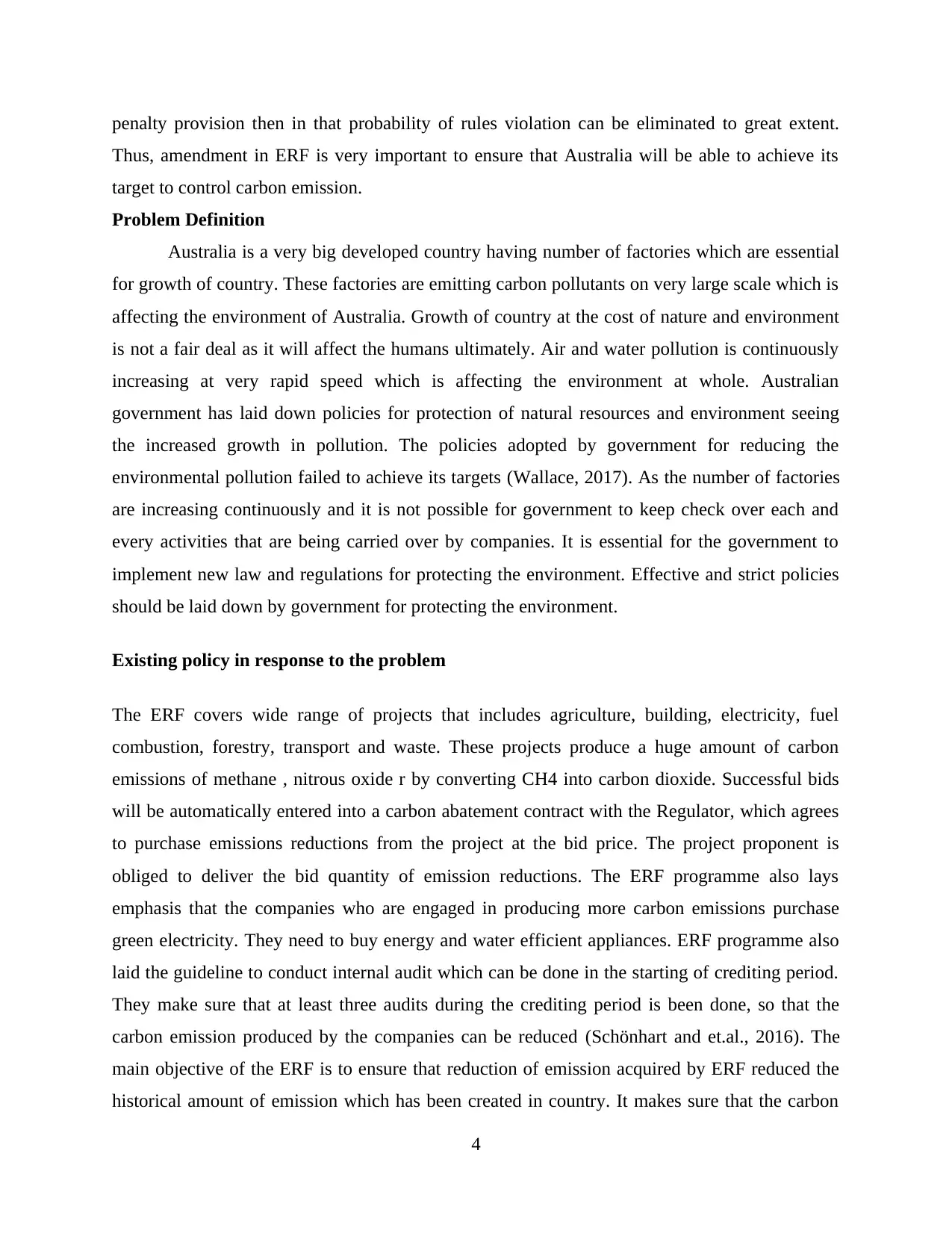
penalty provision then in that probability of rules violation can be eliminated to great extent.
Thus, amendment in ERF is very important to ensure that Australia will be able to achieve its
target to control carbon emission.
Problem Definition
Australia is a very big developed country having number of factories which are essential
for growth of country. These factories are emitting carbon pollutants on very large scale which is
affecting the environment of Australia. Growth of country at the cost of nature and environment
is not a fair deal as it will affect the humans ultimately. Air and water pollution is continuously
increasing at very rapid speed which is affecting the environment at whole. Australian
government has laid down policies for protection of natural resources and environment seeing
the increased growth in pollution. The policies adopted by government for reducing the
environmental pollution failed to achieve its targets (Wallace, 2017). As the number of factories
are increasing continuously and it is not possible for government to keep check over each and
every activities that are being carried over by companies. It is essential for the government to
implement new law and regulations for protecting the environment. Effective and strict policies
should be laid down by government for protecting the environment.
Existing policy in response to the problem
The ERF covers wide range of projects that includes agriculture, building, electricity, fuel
combustion, forestry, transport and waste. These projects produce a huge amount of carbon
emissions of methane , nitrous oxide r by converting CH4 into carbon dioxide. Successful bids
will be automatically entered into a carbon abatement contract with the Regulator, which agrees
to purchase emissions reductions from the project at the bid price. The project proponent is
obliged to deliver the bid quantity of emission reductions. The ERF programme also lays
emphasis that the companies who are engaged in producing more carbon emissions purchase
green electricity. They need to buy energy and water efficient appliances. ERF programme also
laid the guideline to conduct internal audit which can be done in the starting of crediting period.
They make sure that at least three audits during the crediting period is been done, so that the
carbon emission produced by the companies can be reduced (Schönhart and et.al., 2016). The
main objective of the ERF is to ensure that reduction of emission acquired by ERF reduced the
historical amount of emission which has been created in country. It makes sure that the carbon
4
Thus, amendment in ERF is very important to ensure that Australia will be able to achieve its
target to control carbon emission.
Problem Definition
Australia is a very big developed country having number of factories which are essential
for growth of country. These factories are emitting carbon pollutants on very large scale which is
affecting the environment of Australia. Growth of country at the cost of nature and environment
is not a fair deal as it will affect the humans ultimately. Air and water pollution is continuously
increasing at very rapid speed which is affecting the environment at whole. Australian
government has laid down policies for protection of natural resources and environment seeing
the increased growth in pollution. The policies adopted by government for reducing the
environmental pollution failed to achieve its targets (Wallace, 2017). As the number of factories
are increasing continuously and it is not possible for government to keep check over each and
every activities that are being carried over by companies. It is essential for the government to
implement new law and regulations for protecting the environment. Effective and strict policies
should be laid down by government for protecting the environment.
Existing policy in response to the problem
The ERF covers wide range of projects that includes agriculture, building, electricity, fuel
combustion, forestry, transport and waste. These projects produce a huge amount of carbon
emissions of methane , nitrous oxide r by converting CH4 into carbon dioxide. Successful bids
will be automatically entered into a carbon abatement contract with the Regulator, which agrees
to purchase emissions reductions from the project at the bid price. The project proponent is
obliged to deliver the bid quantity of emission reductions. The ERF programme also lays
emphasis that the companies who are engaged in producing more carbon emissions purchase
green electricity. They need to buy energy and water efficient appliances. ERF programme also
laid the guideline to conduct internal audit which can be done in the starting of crediting period.
They make sure that at least three audits during the crediting period is been done, so that the
carbon emission produced by the companies can be reduced (Schönhart and et.al., 2016). The
main objective of the ERF is to ensure that reduction of emission acquired by ERF reduced the
historical amount of emission which has been created in country. It makes sure that the carbon
4
⊘ This is a preview!⊘
Do you want full access?
Subscribe today to unlock all pages.

Trusted by 1+ million students worldwide
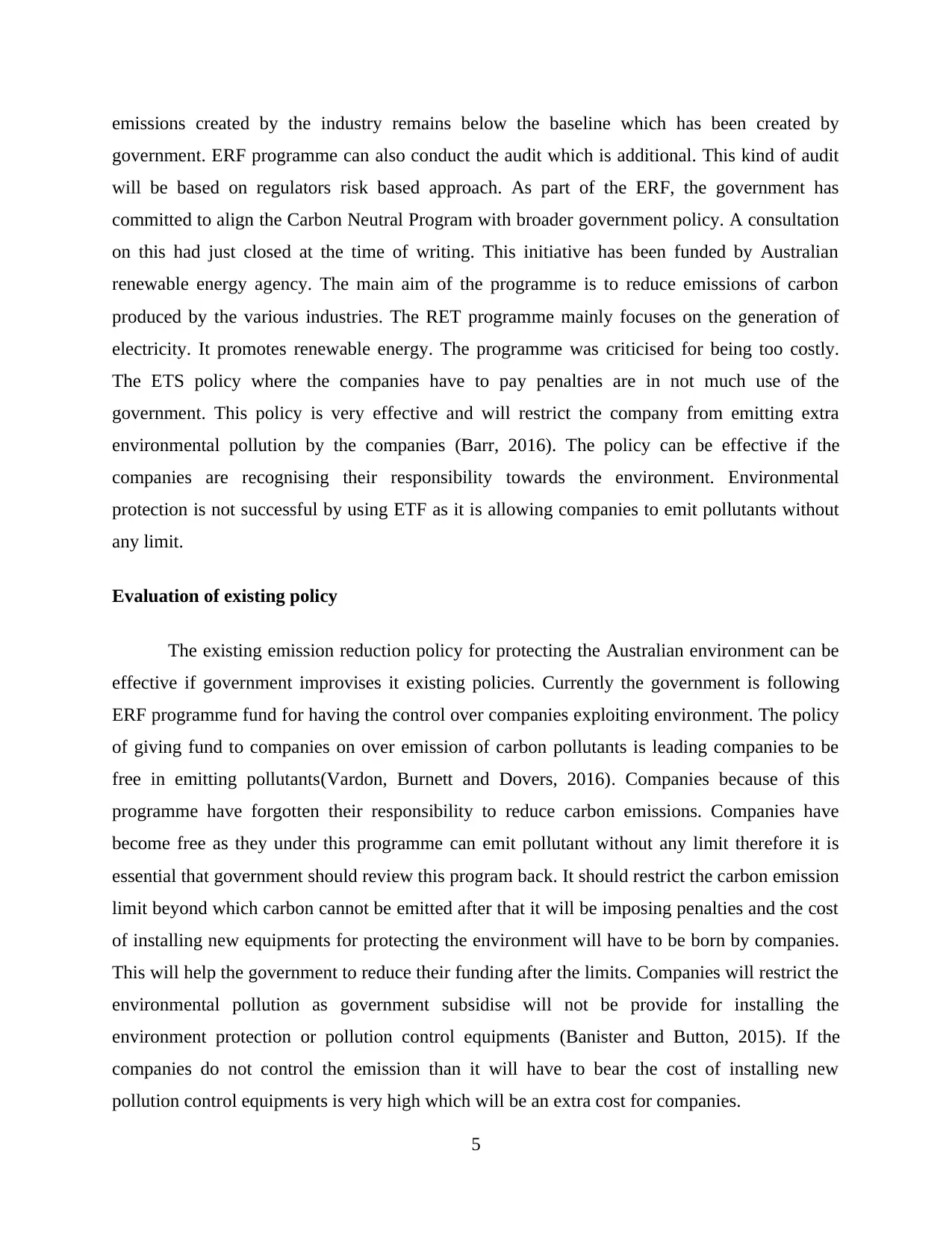
emissions created by the industry remains below the baseline which has been created by
government. ERF programme can also conduct the audit which is additional. This kind of audit
will be based on regulators risk based approach. As part of the ERF, the government has
committed to align the Carbon Neutral Program with broader government policy. A consultation
on this had just closed at the time of writing. This initiative has been funded by Australian
renewable energy agency. The main aim of the programme is to reduce emissions of carbon
produced by the various industries. The RET programme mainly focuses on the generation of
electricity. It promotes renewable energy. The programme was criticised for being too costly.
The ETS policy where the companies have to pay penalties are in not much use of the
government. This policy is very effective and will restrict the company from emitting extra
environmental pollution by the companies (Barr, 2016). The policy can be effective if the
companies are recognising their responsibility towards the environment. Environmental
protection is not successful by using ETF as it is allowing companies to emit pollutants without
any limit.
Evaluation of existing policy
The existing emission reduction policy for protecting the Australian environment can be
effective if government improvises it existing policies. Currently the government is following
ERF programme fund for having the control over companies exploiting environment. The policy
of giving fund to companies on over emission of carbon pollutants is leading companies to be
free in emitting pollutants(Vardon, Burnett and Dovers, 2016). Companies because of this
programme have forgotten their responsibility to reduce carbon emissions. Companies have
become free as they under this programme can emit pollutant without any limit therefore it is
essential that government should review this program back. It should restrict the carbon emission
limit beyond which carbon cannot be emitted after that it will be imposing penalties and the cost
of installing new equipments for protecting the environment will have to be born by companies.
This will help the government to reduce their funding after the limits. Companies will restrict the
environmental pollution as government subsidise will not be provide for installing the
environment protection or pollution control equipments (Banister and Button, 2015). If the
companies do not control the emission than it will have to bear the cost of installing new
pollution control equipments is very high which will be an extra cost for companies.
5
government. ERF programme can also conduct the audit which is additional. This kind of audit
will be based on regulators risk based approach. As part of the ERF, the government has
committed to align the Carbon Neutral Program with broader government policy. A consultation
on this had just closed at the time of writing. This initiative has been funded by Australian
renewable energy agency. The main aim of the programme is to reduce emissions of carbon
produced by the various industries. The RET programme mainly focuses on the generation of
electricity. It promotes renewable energy. The programme was criticised for being too costly.
The ETS policy where the companies have to pay penalties are in not much use of the
government. This policy is very effective and will restrict the company from emitting extra
environmental pollution by the companies (Barr, 2016). The policy can be effective if the
companies are recognising their responsibility towards the environment. Environmental
protection is not successful by using ETF as it is allowing companies to emit pollutants without
any limit.
Evaluation of existing policy
The existing emission reduction policy for protecting the Australian environment can be
effective if government improvises it existing policies. Currently the government is following
ERF programme fund for having the control over companies exploiting environment. The policy
of giving fund to companies on over emission of carbon pollutants is leading companies to be
free in emitting pollutants(Vardon, Burnett and Dovers, 2016). Companies because of this
programme have forgotten their responsibility to reduce carbon emissions. Companies have
become free as they under this programme can emit pollutant without any limit therefore it is
essential that government should review this program back. It should restrict the carbon emission
limit beyond which carbon cannot be emitted after that it will be imposing penalties and the cost
of installing new equipments for protecting the environment will have to be born by companies.
This will help the government to reduce their funding after the limits. Companies will restrict the
environmental pollution as government subsidise will not be provide for installing the
environment protection or pollution control equipments (Banister and Button, 2015). If the
companies do not control the emission than it will have to bear the cost of installing new
pollution control equipments is very high which will be an extra cost for companies.
5
Paraphrase This Document
Need a fresh take? Get an instant paraphrase of this document with our AI Paraphraser
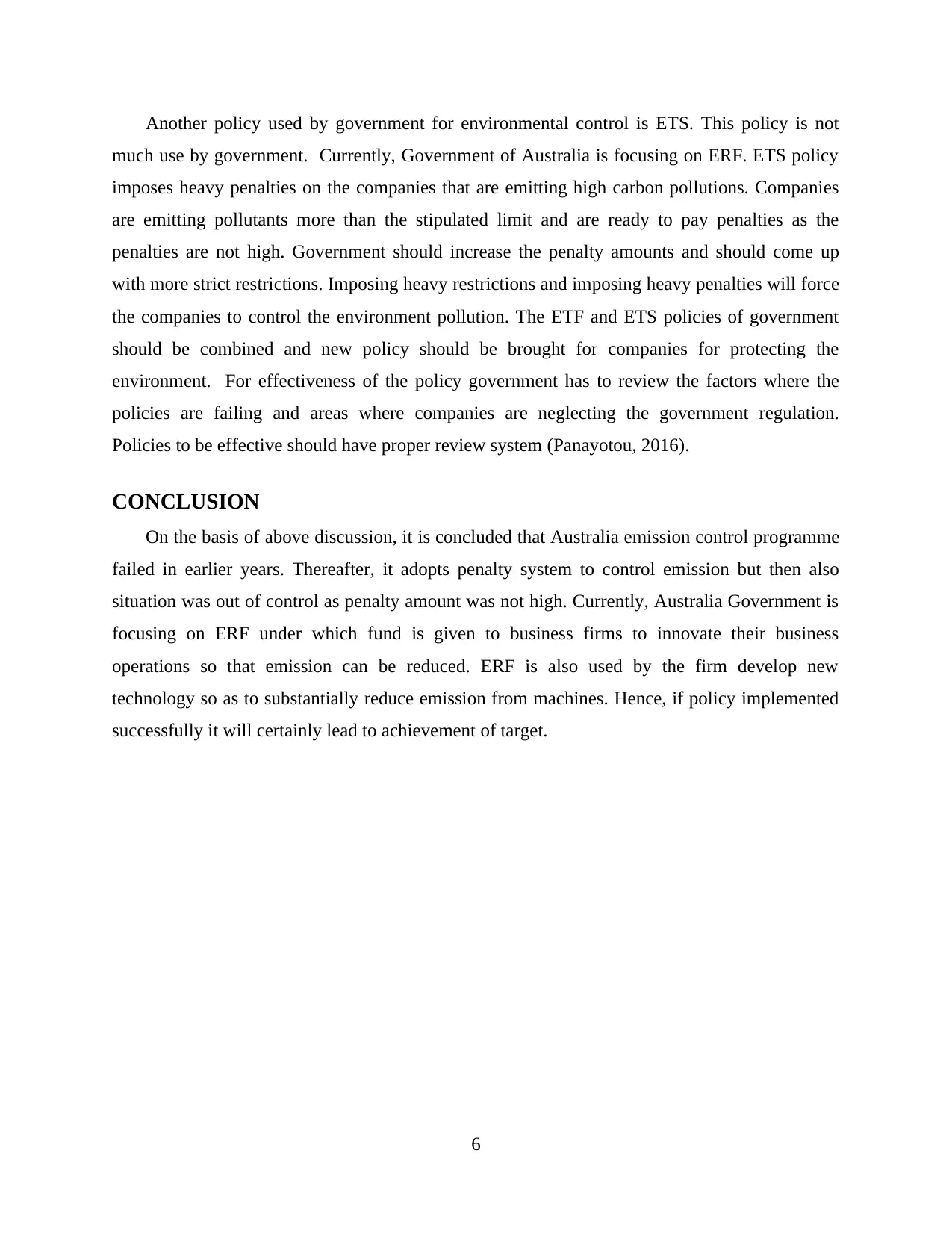
Another policy used by government for environmental control is ETS. This policy is not
much use by government. Currently, Government of Australia is focusing on ERF. ETS policy
imposes heavy penalties on the companies that are emitting high carbon pollutions. Companies
are emitting pollutants more than the stipulated limit and are ready to pay penalties as the
penalties are not high. Government should increase the penalty amounts and should come up
with more strict restrictions. Imposing heavy restrictions and imposing heavy penalties will force
the companies to control the environment pollution. The ETF and ETS policies of government
should be combined and new policy should be brought for companies for protecting the
environment. For effectiveness of the policy government has to review the factors where the
policies are failing and areas where companies are neglecting the government regulation.
Policies to be effective should have proper review system (Panayotou, 2016).
CONCLUSION
On the basis of above discussion, it is concluded that Australia emission control programme
failed in earlier years. Thereafter, it adopts penalty system to control emission but then also
situation was out of control as penalty amount was not high. Currently, Australia Government is
focusing on ERF under which fund is given to business firms to innovate their business
operations so that emission can be reduced. ERF is also used by the firm develop new
technology so as to substantially reduce emission from machines. Hence, if policy implemented
successfully it will certainly lead to achievement of target.
6
much use by government. Currently, Government of Australia is focusing on ERF. ETS policy
imposes heavy penalties on the companies that are emitting high carbon pollutions. Companies
are emitting pollutants more than the stipulated limit and are ready to pay penalties as the
penalties are not high. Government should increase the penalty amounts and should come up
with more strict restrictions. Imposing heavy restrictions and imposing heavy penalties will force
the companies to control the environment pollution. The ETF and ETS policies of government
should be combined and new policy should be brought for companies for protecting the
environment. For effectiveness of the policy government has to review the factors where the
policies are failing and areas where companies are neglecting the government regulation.
Policies to be effective should have proper review system (Panayotou, 2016).
CONCLUSION
On the basis of above discussion, it is concluded that Australia emission control programme
failed in earlier years. Thereafter, it adopts penalty system to control emission but then also
situation was out of control as penalty amount was not high. Currently, Australia Government is
focusing on ERF under which fund is given to business firms to innovate their business
operations so that emission can be reduced. ERF is also used by the firm develop new
technology so as to substantially reduce emission from machines. Hence, if policy implemented
successfully it will certainly lead to achievement of target.
6
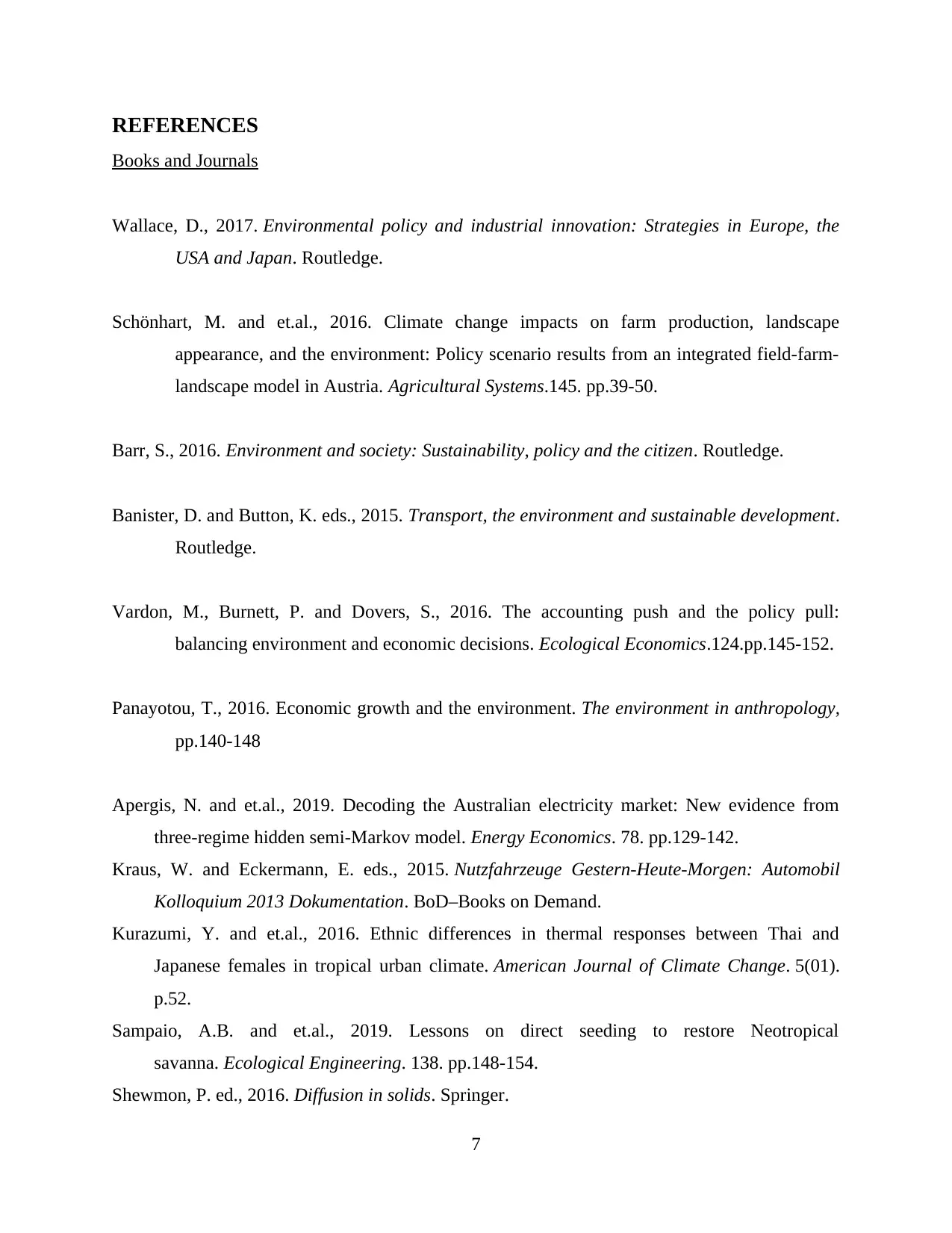
REFERENCES
Books and Journals
Wallace, D., 2017. Environmental policy and industrial innovation: Strategies in Europe, the
USA and Japan. Routledge.
Schönhart, M. and et.al., 2016. Climate change impacts on farm production, landscape
appearance, and the environment: Policy scenario results from an integrated field-farm-
landscape model in Austria. Agricultural Systems.145. pp.39-50.
Barr, S., 2016. Environment and society: Sustainability, policy and the citizen. Routledge.
Banister, D. and Button, K. eds., 2015. Transport, the environment and sustainable development.
Routledge.
Vardon, M., Burnett, P. and Dovers, S., 2016. The accounting push and the policy pull:
balancing environment and economic decisions. Ecological Economics.124.pp.145-152.
Panayotou, T., 2016. Economic growth and the environment. The environment in anthropology,
pp.140-148
Apergis, N. and et.al., 2019. Decoding the Australian electricity market: New evidence from
three-regime hidden semi-Markov model. Energy Economics. 78. pp.129-142.
Kraus, W. and Eckermann, E. eds., 2015. Nutzfahrzeuge Gestern-Heute-Morgen: Automobil
Kolloquium 2013 Dokumentation. BoD–Books on Demand.
Kurazumi, Y. and et.al., 2016. Ethnic differences in thermal responses between Thai and
Japanese females in tropical urban climate. American Journal of Climate Change. 5(01).
p.52.
Sampaio, A.B. and et.al., 2019. Lessons on direct seeding to restore Neotropical
savanna. Ecological Engineering. 138. pp.148-154.
Shewmon, P. ed., 2016. Diffusion in solids. Springer.
7
Books and Journals
Wallace, D., 2017. Environmental policy and industrial innovation: Strategies in Europe, the
USA and Japan. Routledge.
Schönhart, M. and et.al., 2016. Climate change impacts on farm production, landscape
appearance, and the environment: Policy scenario results from an integrated field-farm-
landscape model in Austria. Agricultural Systems.145. pp.39-50.
Barr, S., 2016. Environment and society: Sustainability, policy and the citizen. Routledge.
Banister, D. and Button, K. eds., 2015. Transport, the environment and sustainable development.
Routledge.
Vardon, M., Burnett, P. and Dovers, S., 2016. The accounting push and the policy pull:
balancing environment and economic decisions. Ecological Economics.124.pp.145-152.
Panayotou, T., 2016. Economic growth and the environment. The environment in anthropology,
pp.140-148
Apergis, N. and et.al., 2019. Decoding the Australian electricity market: New evidence from
three-regime hidden semi-Markov model. Energy Economics. 78. pp.129-142.
Kraus, W. and Eckermann, E. eds., 2015. Nutzfahrzeuge Gestern-Heute-Morgen: Automobil
Kolloquium 2013 Dokumentation. BoD–Books on Demand.
Kurazumi, Y. and et.al., 2016. Ethnic differences in thermal responses between Thai and
Japanese females in tropical urban climate. American Journal of Climate Change. 5(01).
p.52.
Sampaio, A.B. and et.al., 2019. Lessons on direct seeding to restore Neotropical
savanna. Ecological Engineering. 138. pp.148-154.
Shewmon, P. ed., 2016. Diffusion in solids. Springer.
7
⊘ This is a preview!⊘
Do you want full access?
Subscribe today to unlock all pages.

Trusted by 1+ million students worldwide

Mandani, S. and et.al., 2015. Carbon nanodots as ligand exchange probes in Au@ C-dot
nanobeacons for fluorescent turn-on detection of biothiols. Nanoscale. 7(5). pp.1802-1808.
8
nanobeacons for fluorescent turn-on detection of biothiols. Nanoscale. 7(5). pp.1802-1808.
8
1 out of 10
Related Documents
Your All-in-One AI-Powered Toolkit for Academic Success.
+13062052269
info@desklib.com
Available 24*7 on WhatsApp / Email
![[object Object]](/_next/static/media/star-bottom.7253800d.svg)
Unlock your academic potential
Copyright © 2020–2025 A2Z Services. All Rights Reserved. Developed and managed by ZUCOL.




